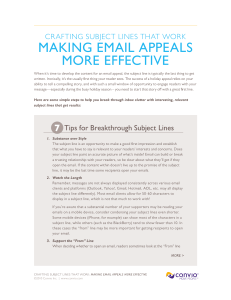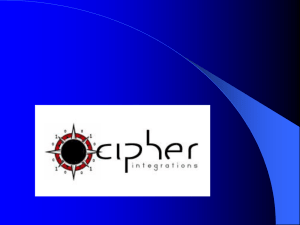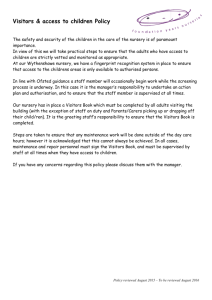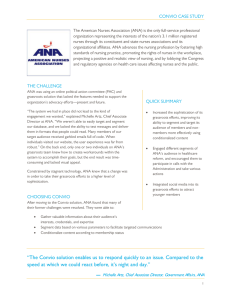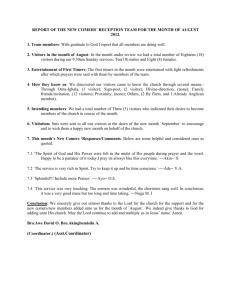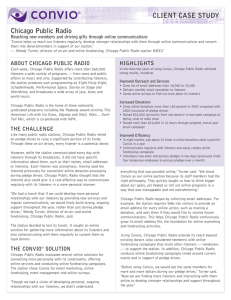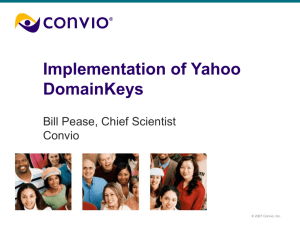The Professional Approach to Web Presence Development
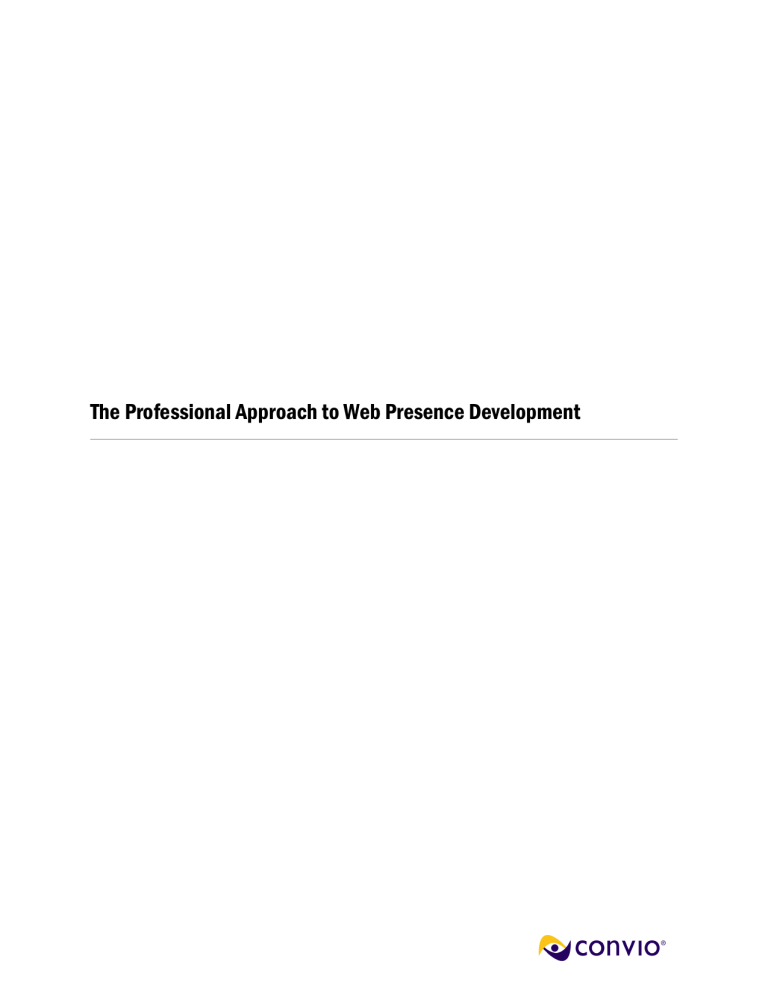
The Professional Approach to Web Presence Development
The Professional Approach to Web Presence Development
Convio takes a collaborative, professional approach to helping clients launch engaging websites that are easy to manage. The methodology used is comprised of a proven series of phases and activities that contribute to the planning, development, and ongoing management of websites that look good and achieve business objectives.
Let’s Stop Talking About “Websites”
At Convio, we have lots of conversations with people about how they plan to use online tools to support their organization’s mission and goals. The language used during these discussions tends to focus on “ websites .” As in,
“you could reach more people with your website, ” “your website needs to be bigger,” or “your website design could be improved”.
When we work on a project that focuses on improving a “website” to increase donations or signups, or to educate the public, we know that thinking about the website alone is not enough. It’s too narrow a definition of what, how and where an organization engages its constituents online.
Many of us are overly concerned about our “website:”
• How big?
• How cool?
•
How pretty?
•
How Web 2.0?
In the real world, your organization is more than an office. And being online requires more than a website — particularly if you want to be successful.
Think about it.
Start Talking About Your Web Presence
A website exists within a much larger landscape that includes a sea of email, a mountain range called social networking, and search outposts dotting the hills. If you don’t consider these other elements, and choose to focus exclusively on your website, then you limit your ability to reach new audiences, drive more traffic, encourage donations, and engage more activists.
You need to use language that describes what your organization is doing online. So let’s start thinking beyond your website and start thinking about your “ web presence .”
Below are four dimensions that define we’re calling a web presence:
The Foundation The Properties
A strong web presence must be built on a solid foundation. The best web presences are created with an understanding of how they will support the organizations' goals, and also include a comprehensive plan.
Later, when we describe the professional approach to web presence development, we’ll cover each element of the foundation in detail. Specifically:
•
The approach an organization takes to
• develop their web presence
The business objectives the presence should support
An organization’s web presence is comprised of multiple websites. Although they may not all be supported by Convio, it’s important to identify them.
Your organization's web presence may include:
•
An organizational or corporate website
•
Various engagement elements o
Acquisition o
Donations o
Advocacy o
Event Registration
•
Micro (or program-oriented) sites
•
Affiliate sites
2
The Professional Approach to Web Presence Development
• The constituents and site visitors that the presence should engage
• The competitive landscape and where an organization fits into it
• Editorial calendars for content production
The Support Structure Marketing Vehicles
Someone needs to conceptualize, build, and maintain an organization's web presence. It is critical to take into consideration the human
In order to engage constituents through their web presence, organizations need to drive traffic to their various websites using a combination of marketing resources required to support this effort. Roles involved include:
• Executives
• Online Strategists
•
Interactive Consultants
•
Visual Designers
•
Web Producers
•
Program Staff
•
Content contributors
The Professional Approach to Developing a Web Presence vehicles, including:
•
Email campaigns
• Social networking sites, such as Facebook
• Social media sites, such as Flickr and YouTube
•
Search engines
•
Print publications
•
Partner sites
Whether you work for a community-based food bank, a national animal rights charity, or an organization somewhere in between, the process for developing an effective web presence involves several integral phases, each of which requires a commitment of time and resources in order to succeed.
Phase One: Plan
In order to build a strong web presence, you should start with the end in mind. Before doing anything else, it’s important to coordinate the following activities.
1.
Online Strategy and Communications Planning
Each website serves a purpose for the organization developing it. It’s important for all of the internal stakeholders involved to reach a consensus on how the website will support the organization’s mission and goals.
Some goals frequently identified by organizations include:
•
Help individuals collaborate
•
Raise more money online
•
Facilitate grassroots policy advocacy
•
Increase registration for events
3
2.
The Professional Approach to Web Presence Development
Discovery & User Research
Your organization’s goals for your website are irrelevant unless website visitors do what you want them to do. But how? You will have to know who your visitors are – activists, senior citizens, teenagers, doctors, attorneys – and what they do and do not like. Next, you will have to figure out what tasks you would like them to perform on your site to support your organization’s goals. Once you’ve got these nailed down, you can start to design your website.
Phase Two: Design
Once you have collected all the necessary information described in phase one, it’s time to begin designing what you plan to build. A well designed web presence is more than attractive colors and compelling images. You need to take a comprehensive approach to the design phase of the process by considering several critical elements.
3.
Information Architecture & Interaction Design
The core of your website isn’t a bunch of pretty pictures … it's the site’s information design. Based on the research you did in steps one and two, you can begin to build elements (such as a sitemap), and define content types, categories, and things some people consider site 'furniture' (e.g., search engines, eCards, and other components).
4.
Visual Design
If you’ve successfully completed steps one through three, you can now provide your designer (internal or consultant) with the inputs required to develop a great looking site that encourages your visitors to support your organization’s goals online. Your designer will consider all of the information you’ve put together, as well as the aesthetic preferences of you and your visitors. A good designer will work with you to develop the following output
•
Wireframes – These are a representation of your homepage and secondary page layouts. Wireframes use boxes and rudimentary labels to outline page structure. They can be easily modified until you're satisfied with the visual representation of the information design.
•
Comps – These are flat image files that incorporate the colors, images, and fonts that will be used in the rendering of your website. Most designers will present anywhere between one and three original comps from which you may choose.
•
Revisions – Once you’ve picked the comp you like best, then you can provide your designer with feedback to make minor tweaks to the comps (e.g. “I think this needs to be bigger or a different color”).
Your designer will then present revised comps, usually going through up to three rounds of revisions.
•
Production Ready Materials – Your designer will transform the flat image file they have been revising into HTML markup, style sheets, separate images, and any JavaScript necessary to allow someone to implement your visual design as your new website.
Example of a Wireframe Example of a Comp
4
The Professional Approach to Web Presence Development
5.
Content/Editorial Planning
As part of the plan and design phases, you may decide to add new content sections and features to your website in order to achieve your organization’s objectives online. Identifying and defining these components at this point of the process is critical to ensure that they are created during deployment and are staffed adequately for maintenance after launch. You should also consider producing an editorial calendar that covers the next year to help anticipate and plan your resource requirements.
5
6.
The Professional Approach to Web Presence Development
Technical Planning and Specifications
At this stage of the project, you will have defined the types of things your site should allow visitors to do, and will have identified special technical requirements needed to achieve the desired level of online interaction.
During this phase you should outline the components of the content management system (CMS) you plan to use. These components should include folders, templates, content types, categories, and workflows. You should also consider your custom development needs (e.g., interactive components particular to your organization’s business).
Planning Document Example
Phase Three: Build
Once you have finished designing the various pieces of your organization's web presence, it’s time to start building.
7.
CMS and/or CRM Deployment
Once you have completed steps one through six, you (or a consultant or software company) are ready to implement your site using the software you’ve chosen to power it. This step involves configuring the software to accommodate your content types, sitemap, and visual design. It also usually involves customization of the system and training of staff members who will create and modify site content. If you are moving from one site to another, then you will have to consider how much content to bring from the original site to the new one. If you’ve done a good job with your information design, then you will most likely only bring essential content to the new site, casting aside the old content.
8.
Custom Development
If you're working with a CMS deployment partner for your organization’s website, they will develop the code that supports the custom components you identified during the technical planning and specifications phase.
9.
Training
Your team will participate in training on the CMS that will be used to support your website. The training people receive should be relevant to their role within the organization. For example, lead web producers should receive in-depth training on most of the system, whereas content authors should be trained only on
6
The Professional Approach to Web Presence Development functionality related to creating, editing and publishing content.
Phase Four: Launch
At this point you’re almost at the goal line. All of the essential elements of your web presence should be functional and ready to use.
10.
Content Production and Quality Assurance
In many cases, organizations find it necessary to write lots of content for the new site. In some cases your organization will migrate content from an existing site to the new one. The way in which you move content will depend on how your old content has been stored. You can either copy and paste each page into the
CMS or, in some cases, import the content in bulk.
After content is migrated into the CMS, you need to develop and implement a plan for quality assurance.
Such a plan typically involves the manual review of the majority of site content to ensure links work, images load, and content is complete.
11.
Launch
Once the quality of the site meets your organization’s standards, your site is ready for launch! Because you will have been working on your site in a staging environment, it’s necessary to run migration scripts and make some adjustments to the domain name system (DNS) to make sure that requests for your site are directed to the CMS-hosted content. Shortly after launch, website visitors will begin arriving at the front door of your new website!
12.
Ongoing Campaign Management and/or Interactive Services
To ensure the ongoing success of your website, it’s important to have resources dedicated to the production of new content and web features. This proactive approach will ensure that your website offers visitors fresh and valuable content, and that the site continues to reflect your organization’s objectives as they evolve.
So, that’s it — the professional approach. Above all, remember that your web presence is a living thing. As your business goals evolve, so too must your web presence. Revisit this approach periodically to ensure you’re making choices that support the development of a web presence (not a website) — one that has a maximum impact on your organization's goals online.
7
The Professional Approach to Web Presence Development
About Convio
Convio is the leading provider of on-demand constituent relationship management (CRM) software and services that give nonprofit organizations a better way to inspire and mobilize people to support their organization. The company’s online marketing suite offers integrated software for fundraising, advocacy, events, email marketing and web content management, and its
Common Ground™ CRM system helps organizations efficiently track and manage all interactions with supporters. All Convio products are delivered through the Software-as-a-Service (SaaS) model and are backed by a portfolio of best-in-class consulting and support services and a network of partners who provide value-added services and applications focused on the unique needs of nonprofit organizations.
Austin | Berkeley | Washington, DC
888-528-9501 | 512-652-2600 | info@convio.com | www.convio.com
Convio, the Convio logo, TeamRaiser and Constituent360 are trademarks, registered trademarks or service marks of Convio, Inc. All other names are trademarks, registered trademarks or service marks of their respective owners. V. 09.22.08
8
